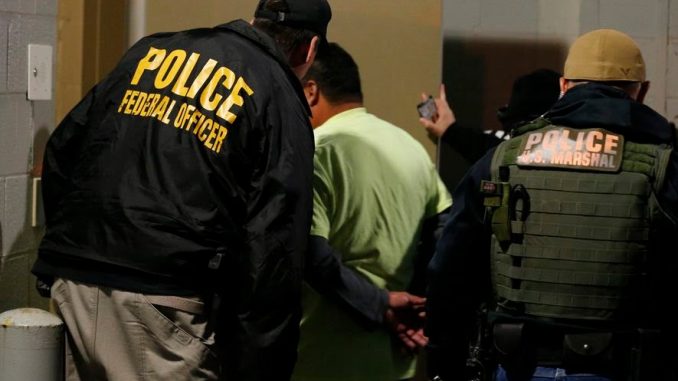
Homeland Security’s success in curbing the border crisis came at a cost: ICE saw its arrest numbers tumble over the last year, officials revealed Thursday, saying they had to pull personnel off their usual duties of tracking illegal immigrants and gangs to send them to the border.
Acting Director Matt Albence said ICE made about 15,000 fewer arrests of “criminal aliens,” or immigrants who have racked up charges or convictions beyond immigration violations, and he blamed the border surge, judicial resistance and a growing number of sanctuary cities for cutting into the numbers.
“We’ve had to redeploy our ICE resources to support the Border Patrol and Customs and Border Protection with those challenges at the border, which has made us less safe because we’ve had some field offices where we’ve had to shut down our at-large criminal alien teams so that they could handle the influx of people that are coming to this country illegally, as well as the increase in people in detention,” Mr. Albence said at a White House press conference, standing alongside sheriffs who begged for more respect for ICE.
The border surge also took a toll on the immigration courts, with Homeland Security filing a record 444,000 new cases in fiscal year 2019.
That’s almost double the numbers during the Obama administration, and it reflects the massive number of asylum and complex deportation cases that had to be brought against caravans and other illegal immigrants that streamed toward the U.S. this year.
The Executive Office of Immigration Review, which oversees the courts, said it cleared cases at a near-record pace, closing out more than 275,000 — up 80,000 from a year earlier. But EOIR was overwhelmed by the sheer number of new cases, sending its backlog up to nearly 1 million cases.
“Our immigration courts are doing everything in their power to efficiently adjudicate immigration cases while respecting due process rights, but efficient adjudication alone cannot resolve the crisis at the border,” said James McHenry, director of EOIR.
The revelations come as the administration takes stock of the just-concluded fiscal year, which ended Sept. 30.
Border captures will total nearly 1 million — but that’s actually better than feared this spring, when Customs and Border Protection nabbed 144,000 people in May alone, setting records for the number of children and families.
Those numbers have improved dramatically, with roughly 52,000 captures in September, officials announced this week.
Acting Homeland Security Secretary Kevin McAleenan said the department has made such headway that it is about to end catch-and-release of illegal immigrant families.
Yet the effects of the surge are tough to overstate.
ICE officers who usually scour prisons and jails for illegal immigrants with criminal records were pulled off duty and sent to the border where they were tasked with facilitating catch-and-release by opening doors on vans to actually release the illegal immigrants who’d just been caught.
With officers distracted, ICE’s arrests tumbled to about 140,000 in fiscal year 2019, Mr. Albence said.
He said 75% of those arrests came from scouring prisons and jails for illegal immigrants with criminal records. The other 25% were from the at-large teams tracking down fugitives.
He pushed back against the constraints on his agency’s ability to go after those migrants in jails.
In particular, he unloaded on a federal judge who issued a ruling late last month puncturing the detainer system ICE uses to try to get local authorities to turn over illegal immigrants they encounter. Judge Andre Birotte Jr., whom President Barack Obama appointee to the bench, said the computer systems ICE uses are so unreliable that it’s snaring U.S. citizens and others who shouldn’t be detained.
“This decision will threaten public safety as it will lead to the release of criminal aliens back onto the street,” Mr. Albence said.
The acting ICE chief also blasted sanctuary jurisdictions that limit cooperation with ICE, saying they too endanger communities by releasing illegal immigrants.
One Texas sheriff who stood alongside Mr. Albence compared anti-ICE sentiment sweeping the country to the treatment aimed at returning Vietnam war veterans, saying Thursday that deportation officers are being vilified for enforcing laws Congress passed.
“They’re eviscerating honorable people doing noble things, standing on the wall between good and evil for you and me,” said Bill Waybourn, the sheriff of Tarrant County, which contains Fort Worth.
ICE revealed one sanctuary case this week out of Oklahoma, where the agency says the Oklahoma County Sheriff’s Department defied a detainer request placed on an accused rapist, and instead released him onto the streets.
Hours later, ICE said, suspect Antonio Ulises Perez was back at the door of the woman he is accused of having raped.
ICE deportations officers were eventually able to round the suspect up and he now awaits deportation proceedings, the agency said.
“It is unconscionable that someone who is sworn to uphold the law would find it acceptable to release an alleged rapist who is illegally present in the U.S. back into the community when there are other options available under federal immigration law,” said Marc Moore, director of ICE’s Dallas field office.
The sheriff’s department, in a statement, said ICE was wrong on several counts.
The department said another agency, not the sheriff’s department, made the arrest. And while Mr. Perez was booked on suspicion of rape, he was never formally charged, the department said.
Beyond that, the sheriff’s department said it does try to cooperate with ICE, and even allows space in its jail for agents. The department said ICE didn’t have a warrant to justify holding Mr. Lopez for pickup, but said they did alert ICE of his impending release.
“ICE had an hour and a half to take the individual into custody but did not send anyone to pick up the individual before his scheduled release, and, without any legal authority to hold the individual, he was released,” the sheriff’s office said.
*story by Washington Times